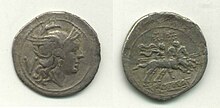Balsthal hoard
The Balsthal Hort is a Celtic deposit that was made in the canton of Solothurn in Switzerland in 1839/40 . The Hort was about 500 m southwest of the Holzfluh , a prominent hill near Balsthal . The Holzfluh is said to have been settled in the Bronze and Hallstatt Ages , as well as in the Late Latene Age.
Of the estimated amount that was mostly lost, only 10% (17 coins) have been preserved. Of the so-called Gallic or Helvetic quinars , nine are tuft quinars and eight are NINNO quinars. These include two ancient forgeries (coins with a copper or bronze core). The combination of these two types of coins is so far rare in hoarding. The quinaries represented in Balsthal occur in the oppidum on the Basler Münsterhügel, in Bern in the Engemeisterfeld and in the Reichenbachwald , that is, only in younger oppida . The comparative finds suggest that the coins in the 3rd quarter of the 1st century BC. Were in circulation.
A silver deer antler, which is said to have been about 15 cm long, was also lost. Even if comparable objects made of silver are missing, there are pictorial and plastic representations as well as finds of real deer antlers . The antlers of bronze of Evreux ( Eure , France ), could be a statue used in the head and was buried in a sanctuary. In a pit near Levroux , ( Département Indre , France), a deer antler was laid down together with a statue, a coin, a mold for pouring coin blanks and other objects.
The investigation of Celtic depot finds, in which coins are found associated with other valuable objects, has shown that these are depots with a sacred character. This is especially true for depots with prestige objects. With over 150 quinars and an item made of solid silver, the Balsthal hoard also belongs to this category.
literature
- Susanne Frey-Kupper : The Celtic hoard from Balsthal. A sacred deposit . In: Archeology of Switzerland 23, 1999, ISSN 0255-9005 , pp. 83-87.
